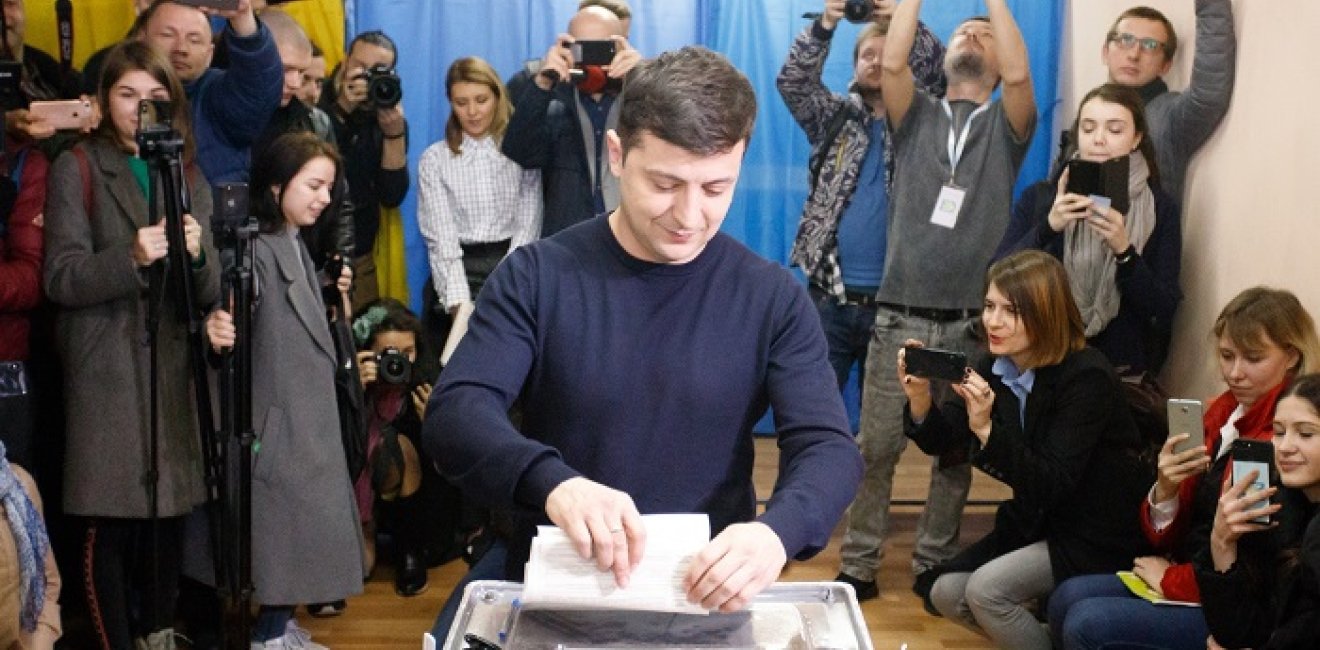
A blog of the Kennan Institute
BY ANDRIAN PROKIP
A few days before the second round of elections, every person in Ukraine is guessing how the country might be governed differently by the two presidential contenders. Society is divided. Some believe that only Petro Poroshenko could defend the country adequately and fend off Russia, while at the same time integrating with the EU and NATO. These voters also believe that the other contender for the office of president, Volodymyr Zelenskiy, a showman without political experience, would turn out to be a weak president unable to match in any way Putin’s vast experience. As well, some are concerned he may be a pro-Russia leader.
The other group of voters, who constitute the majority in every region and among every age cohort of Ukrainian voters, support Zelenskiy as a newcomer untainted by past conflicts and corruption scandals. They are evidently tired of President Poroshenko and other veterans of Ukrainian politics.
Many citizens expect from the next president not only national security, military strength, and wise foreign policy but also an improvement in their personal well-being and the prosperity of their family. According to the Ukrainian constitution, the president is responsible for guaranteeing the rights and liberties of citizens, the defense of the country, and foreign policy; presidents are not expected to be directly involved in the economy. However, Ukrainians know perfectly well that presidents, through their relations with the ministers and parliament, have their hand on the scale of economic development. Many voters are rightly concerned with how Ukraine will survive the challenges of debt repayment and economic growth in the next five years, and how each of the presidential contenders might cope with those challenges.
Pressing Economic Issues
In 2018, Ukraine enjoyed its lowest inflation rate and highest GDP growth since 2013, with the economy showing stable growth. Yakov Smolii, head of the National Bank of Ukraine, has even called it a year of macrofinancial stability.
Nonetheless, a 3 percent average GDP growth is not truly satisfactory for Ukraine. After an almost 16 percent decline in GDP in 2013–2014, at such a modest growth rate the country would need more than ten years to achieve the GDP of the precrisis period, prior to Russian incursions. Under current conditions, the country will need more foreign investments, which continue to be lower than needed to prime the economic pump.
The country is heavily dependent on foreign macrofinancial assistance, which Ukrainian governments have worked hard to attract over the years. And in the coming two years Ukraine is obligated to make record-high debt repayments. To do so, Ukraine will have to take on new loans, which are expected to become available if reforms are continued and sped up.
Another critical issue is labor migration. Many Ukrainians leave for seasonal or permanent work elsewhere and send money back to their families in Ukraine. In 2018, these transfers amounted to U.S. $14 billion, which is close to 10 percent of GDP and four times greater than foreign direct investment. But with time, these transfers will decrease. If the economic situation does not improve, more people will be looking for a chance to remain abroad forever. Another key question, then, is how the presidential contenders plan to create jobs at home to retain workers.
Contenders’ Responses
Both candidates for the presidency have laid out plans to avoid economic hardship.
Should Petro Poroshenko win another five years, there probably will be no serious change in economic policy. According to his platform he sees Ukraine as an industrially developed country in the top tier of IT industry nations and agricultural products exporters, a transport hub, and a regional tourism center, with a low poverty rate. His platform does not describe the specific steps necessary to achieve these goals but only a direction for the strategic development of the economy. That approach makes sense, insofar as this area is not a direct responsibility of the president.
Zelenskiy, who currently has a better chance at capturing the presidency, seeks to turn Ukraine into a wealthy country with a solid economy, good domestic working conditions, and a low emigration rate; he also sees Ukraine as a net energy exporter. Mostly, he expects to achieve these aims by changing economic policy and improving the environment for doing business. The economic part of his platform offers some taxation changes (changing the system of taxing businesses’ profits—the same as Poroshenko offers; eliminating the value added tax and introducing a turnover tax instead; and similar measures), amnesty for capital (people will be able to declare their “shadow” wealth once, and pay a 5 percent tax on it), introducing a transparent land market, offering more guarantees for foreign investors, making bank loans cheaper, and so on.
An Unpredictable Post-election Economic Policy
Frankly, Zelenskiy’s proposals do not differ significantly from Poroshenko’s proposals, or from what the government is currently doing. Key elements of both presidential contenders’ plans for Ukraine include energy self-sufficiency, an improved business environment, protection of investors’ rights, and wage and salary improvements.
Neither presidential contender can guarantee that this program will be implemented after the election. Also, there is no obligation for a president to move forward on campaign promises. In 2011 the Supreme Administrative Court decided that Viktor Yanukovych’s failure to implement his electoral platform was not a violation of the law.
If, however, the president has the political will to improve the economy, he will need the full cooperation of the cabinet and parliament, and this is where economic policy may be subordinated to politics. Volodymyr Groysman will most likely remain prime minister until the October parliamentary elections and continue to hold the reins of economic policy. Should Zelenskiy become president, he may anticipate clashes with Groysman and try to install a new prime minister. Also, it is not clear how Zelenskiy would go about forging a relationship with powerful oligarchs and big business. These political uncertainties could in turn make economic policy quite unpredictable for several months after the conclusion of the presidential elections.
Political instability and unpredictability in the policy realm are never good for the economy. The period of 2019–2020 stands to be a challenging one for the Ukrainian economy.
Author

Director, Energy Program, Ukrainian Institute for the Future

Kennan Institute
After more than 50 years as a vital part of the Wilson Center legacy, the Kennan Institute has become an independent think tank. You can find the current website for the Kennan Institute at kennaninstitute.org. Please look for future announcements about partnership activities between the Wilson Center and the Kennan Institute at Wilson Center Press Room. The Kennan Institute is the premier US center for advanced research on Eurasia and the oldest and largest regional program at the Woodrow Wilson International Center for Scholars. The Kennan Institute is committed to improving American understanding of Russia, Ukraine, Central Asia, the South Caucasus, and the surrounding region through research and exchange. Read more

Explore More in Focus Ukraine
Browse Focus Ukraine
Talking to the Dead to Heal the Living

Ukrainian Issue in Polish Elections


